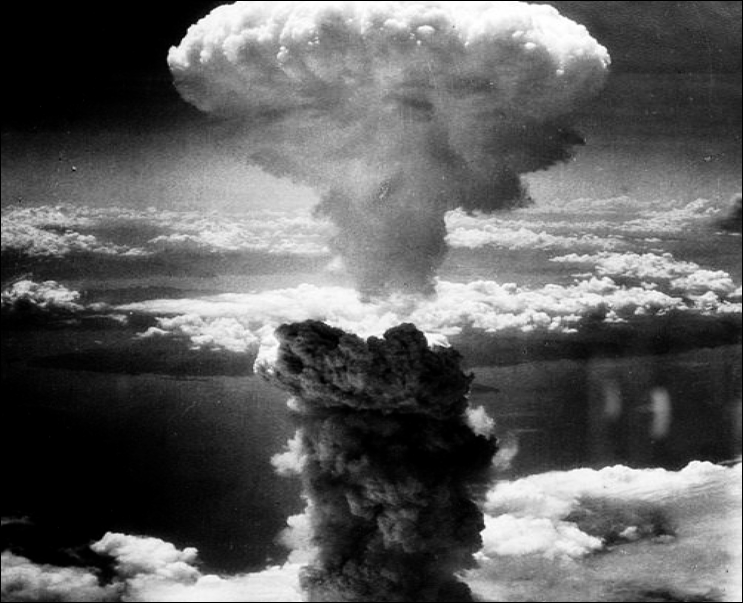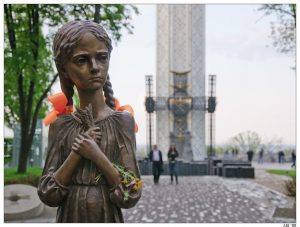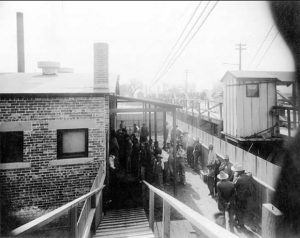Winner of the Spring 2017 StMU History Media Awards for
Best Article in the Category of “World History”
“We knew the world would not be the same. A few people laughed, a few people cried, most people were silent. I remembered the line from the Hindu scripture the Bhagavad Gita. Vishnu is trying to persuade the prince that he should do his duty and to impress him takes on his multiarmed form and says, ‘Now, I am become Death, the destroyer of worlds.’ I suppose we all thought that one way or another.”1
- J. Robert Oppenheimer, The Decision to Drop the Bomb

Throughout the history of human warfare, conflict has pushed humans to innovate–to build ever larger and deadlier weapons, each more lethal than the last. However, it was not until World War II and the invention of the atomic bomb that humanity has been able to kill on such a massive and efficient scale. Case in point, in the final days of World War II, the United States carried out one of the most chilling instances of mass murder in the history of humanity: the bombing of the Japanese cities of Hiroshima and Nagasaki. These attacks ultimately killed an estimated 294,000 people, the majority of whom were noncombatants.2 In comparison, the Japanese attack on Pearl Harbor killed just 2,408 American citizens, although this is largely due to the focused Japanese attack on military targets, namely the Pacific fleet and U.S. airfields.3 To give a more modern frame of comparison, the terrorist attacks against the World Trade Center and Pentagon, considered to be by far the worst terrorist attacks against the United States, claimed the lives of 2,974 American citizens.4
In the spring of 1945, World War II was entering its final stages. The Allies had already achieved victory in Europe with Germany’s surrender on May 7th, but the conflict on the Pacific front was still going strong. In the years leading up to the two World Wars, Japan’s victories against two larger countries–China in the Sino-Japanese War (1894–1895) and Russia in the Russo-Japanese War (1904–1905)–combined with other factors, forged a strong sense of Japanese nationalism, militarism, and cultural superiority. This fervent nationalism, integrated with the Japanese warrior ethic known as bushido, made the prospect of a Japanese surrender unlikely, even as the Allies began to position for an invasion of the Japanese mainland.5

Concurrently, since as early as 1942, President Franklin Delano Roosevelt had been secretly sponsoring and funding The Manhattan Project, the code name used for the $2 billion U.S. effort to develop a nuclear weapon before the Germans. A team of top physicists led by Dr. Julius Robert Oppenheimer were assigned to this project, a task so secret that not even individuals as important as then Vice President Harry S. Truman was aware of it. Shortly after Roosevelt’s untimely death and Truman’s subsequent inauguration to the presidency in April 1945, he was informed that the Manhattan Project was approaching success–that a nuclear weapon would be feasible in just four short months.6
Faced with the prospect of a costly and deadly invasion of Japan, Truman and his advisors were faced with a difficult choice: utilize this new atomic weapon or try to defeat Japan through conventional means. In late July, the United States issued the Postdam Declaration, a statement which gave Japan the choice between unconditional surrender or total annihilation. When this declaration went ignored, President Truman authorized the use of the atomic bomb.7

On the morning of August 6, 1945, Colonel Paul Tibbets piloted the Enola Gay over the city of Hiroshima, where his crew dropped an atomic bomb code-named “Little Boy.” Upwards of 70,000 people died instantly in the blast. Additionally, 48,000 buildings were destroyed and another 22,000 were damaged, leaving only 6,000 buildings untouched. Three days later, on August 9th, a second bomb was dropped onto Nagasaki, killing another 36,000 people. In total, an estimated 295,000 were killed in the blasts or from complications from the resulting nuclear fallout.8
Emperor Hirohito ordered the surrender of Japan on August 10, 1945. On August 15th, radios across Japan broadcasted Hirohito’s words as he read the declaration of surrender to the Japanese people, thus ending World War II. The bombs’ effectiveness in forcing the Japanese to surrender is still subject of popular debate among historians to this day, given that the Russian invasion of Japan-controlled Manchuria occurred at the same time of Nagasaki, both of which likely impacted Japan’s will to continue fighting.9 Even so, while the political and military effects of these blasts may be debated, none can contest their tragedy and devastation.

- Jason Pontin, “Oppenheimer’s Ghost,” MIT Technology Review, October 15, 2007. https://www.technologyreview.com/s/408835/oppenheimers-ghost/. ↵
- Dennis W. Cheek, “Hiroshima and Nagasaki,” in Encyclopedia of Science, Technology, and Ethics, edited by Carl Mitcham, Vol. 2, Detroit: Macmillan Reference USA, 2005. Gale Virtual Reference Library (accessed February 6, 2017), 923. ↵
- Sonia Benson, Daniel E. Brannen, Jr., and Rebecca Valentine, “Pearl Harbor Attack,” in UXL Encyclopedia of U.S. History, Vol. 6, Detroit: UXL, 2009. Gale Virtual Reference Library (accessed February 6, 2017), 1208. ↵
- Stefan M. Brooks, “September 11 Attacks,” in The Encyclopedia of Middle East Wars: The United States in the Persian Gulf, Afghanistan, and Iraq Conflicts, edited by Spencer C. Tucker, Vol. 3, Santa Barbara, CA: ABC-CLIO, 2010. Gale Virtual Reference Library (accessed February 6, 2017), 1096. ↵
- “The United States Drops the Atomic Bomb on Hiroshima and Nagasaki,” in Global Events: Milestone Events Throughout History, edited by Jennifer Stock, Vol. 2, Asia and Oceania, Farmington Hills, MI: Gale, 2014. Gale Virtual Reference Library (accessed February 5, 2017), 361. ↵
- “An Overview of the Atomic Bombings of Hiroshima and Nagasaki,” in The Atomic Bombings of Hiroshima and Nagasaki, edited by Sylvia Engdahl, Perspectives on Modern World History, Detroit: Greenhaven Press, 2011. Gale Virtual Reference Library (accessed February 6, 2017), 13-14. ↵
- “An Overview of the Atomic Bombings of Hiroshima and Nagasaki,” in The Atomic Bombings of Hiroshima and Nagasaki, edited by Sylvia Engdahl, Perspectives on Modern World History, Detroit: Greenhaven Press, 2011. Gale Virtual Reference Library (accessed February 6, 2017), 14-15. ↵
- Dennis W. Cheek, “Hiroshima and Nagasaki,” in Encyclopedia of Science, Technology, and Ethics, edited by Carl Mitcham, Vol. 2, Detroit: Macmillan Reference USA, 2005. Gale Virtual Reference Library (accessed February 6, 2017), 923. ↵
- “The United States Drops the Atomic Bomb on Hiroshima and Nagasaki,” in Global Events: Milestone Events Throughout History, edited by Jennifer Stock, Vol. 2, Asia and Oceania, Farmington Hills, MI: Gale, 2014. Gale Virtual Reference Library (accessed February 5, 2017), 361. ↵



152 comments
Osman Rodriguez
This particular event in history is very important and still relevant today. The effects of such bombings were devastating and ultimately horrific. It was a tough decision and one that impacted the way the world works in terms of military and nuclear weapons. I wonder how things would work if the two nuclear bombs were not dropped. A second article on the aftermath of the bombs would be a great idea. I would like to read about the effects of the nuclear fallout.
Maria Callejas
Amazing title! Nuclear bombs indeed changed warfare forever. I have to say that the initial quote intensifies the mood which attracts the reader right away. Great usage of evidence, I had no idea so they were many casualties in the Hiroshima/Nagasaki attacks – and comparing that number to the deaths of 9/11 also emphasizes the magnitude of it. It is astonishing to realize that Japan had the opportunity to surrender (preventing so many deaths and destruction) but they simply didn’t do it. Great conclusion, undoubtedly, even though it was effective in terms of war, the tragedy brought by the bomb is utterly monstrous.
Ernie Sano
Warfare is often regarded as a moral dilemma that cannot be justified or unjustified. It is a construct of what we humans value most, our own lives. Taking another life in order to save your own is an ethical conundrum that may very well be one of the hardest decisions a person would have to make. Empathy and compassion battle with the ruthlessness and insensitivity every human has, and at times, create events that are catastrophic, such as the bombings explained in the article.
Joel Gracia
It is chilling to think that the biggest single terrorist attack that the world has ever seen was actually committed by our own country. We have a national day commemorating a terrorist attack against us that isn’t even a fraction as big as the one that we caused. That doesn’t make either event okay, but it’s important to read articles like these and remember that we are not innocent in the least.
Eduardo Foster
The article is interesting! It is enjoyable to read, and to also know some of the reasons why the United States ended using the atomic bombs. It is interesting to get to know facts such as how many people died in events such as Hiroshima and Nagasaki in comparison to other events like Pearl Harbor and 9/11. I’ll be looking forward to read some of your other works!
Blanca Martinez
I’ve always been a history nut but never truly did much research in order to find out more about an event, especially if said event takes me into a meloncholic area. Your article gave me many insights about what I’ve missed about the ending of World War 2. I didn’t know that the bombing in Nagasaki had happened at the same time as the Russian invasion in Japan-controlled Manchuria, in all honesty I thought that Japan surrendered just because of both bombings. Thanks to this well put article, I learned many things, thank you.
Troy Leonard
this was a great article to read ill have to say. I really like to see fact it to what I’m reading and I think you did a great job at that. its very shocking that, that many people lost their life because of these nuclear war heads. we can only imagine what kind of weapons that these countries have in their hand no a days due to how my technology has been updated. militaries are more o the technology side so them may have weapons powerful enough to take out the whole world.
Marco Picardo
Well written article. One could even compare the atomic bombings to the attacks Islamic terrorist carry out on innocent civilians, or more specifically, Al-Qaeda’s 9/11 attacks. Both were attacks focused on innocent civilians and had a purpose of invoking fatalities and fear. Some would argue you could even label such a bombing as a warcrime. But then again, history is always written by the victor.
Matthew Rios
Your article was clear and concise without a hint of bias. Truly felt like the work a professional. I don’t think there’s a more appropriate way to address the history the way you did, because while we question the leaders decisions who predate us, it certainly is a privilege to still be here because of them. Without this weapon there’s no telling how history would have been written.
Richard Navarro
This article brought history to life for a moment. The numbers of the non-combatants involved were outrageous. It was a very interesting article at that. Of course, there are people on both sides of the fence on whether the bombings in Hiroshima and Nagasaki were appropriate. Whether right or wrong, it ended the war between us and kept many American soldiers alive.